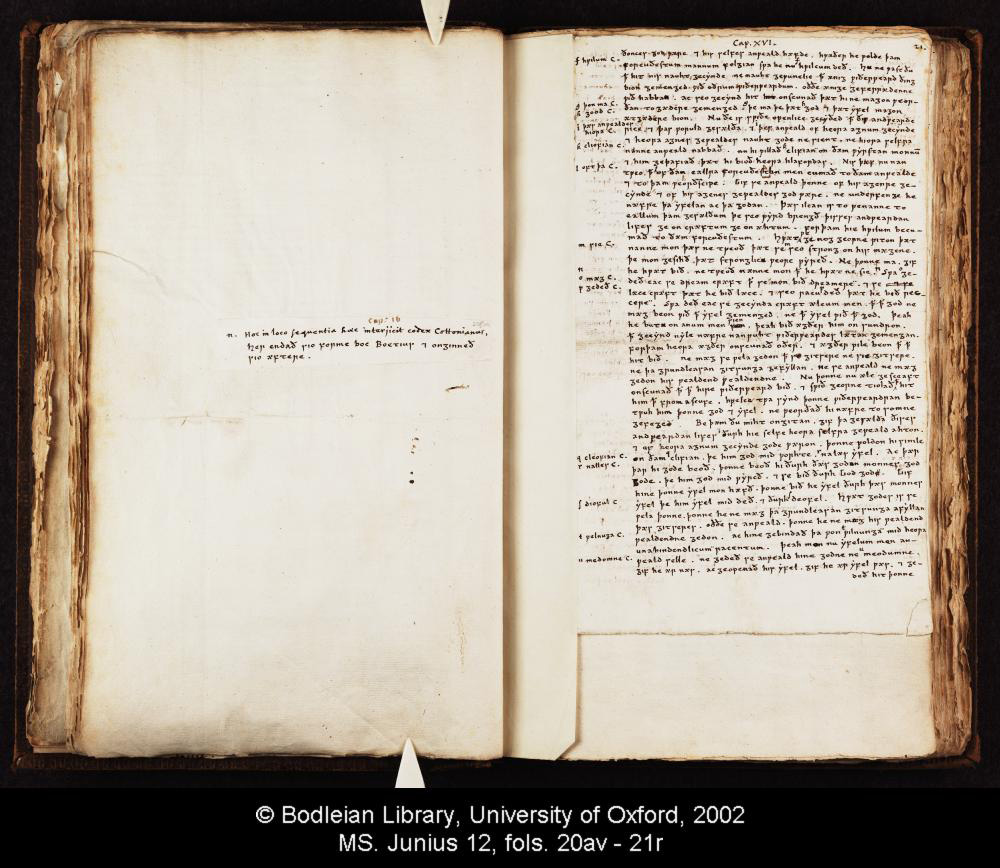
For a preliminary discussion of the complex relationship between Cotton Otho A. vi and the other manuscripts and modern editions, see Kiernan, “Alfred the Great’s Burnt Boethius,” The Iconic Page in Manuscript, Print, and Digital Culture, edited by George Bornstein and Theresa Tinkle. Ann Arbor: University of Michigan Press, 1998. 7-32.
London, British Library, MS Cotton Otho A. vi:
The primary source for the Old English Consolation of Philosophy is the tenth-century British Library Cotton MS, Otho A. vi, the only surviving copy of Alfred the Great’s prose and verse translation of Boethius. Mistakenly considered lost in the same infamous Cotton Library fire in 1731 that burned away the edges of the Beowulf manuscript, the burnt remains of Otho A. vi were rediscovered by Frederic Madden in a garret at the British Museum in the middle of the nineteenth-century (see Andrew Prescott, “‘Their Present Miserable State of Cremation’: the Restoration of the Cotton Library).” Under Madden's supervision, the burnt leaves were placed in individual paper frames of the restoration binding by Henry Gough in 1844.

Neil Ker in his Catalogue dates the script in the mid-tenth century (Humphrey Wanley dates it a half-century earlier, around the time of Alfred’s death). Ker describes the script as “a well-formed Anglo-Saxon minuscule, throughout by one hand: high e ligatures, including ea and eo ligatures: straight-topped a: p with open bow terminated by a short serif or cross-stroke: ligature of double low s: long s only before t c p: the curve of final t sometimes curled up: ð regular, þ rare: y rounded and without dot. The initials have not been filled in in the spaces left for them” (Ker 167).
Oxford University, Bodleian Library, MS Bodley 180:
A version of Alfred’s Boethius entirely in prose survives in the twelfth-century Oxford, Bodleian Library, MS Bodley 180. Most scholars believe that this all-prose version predates the prose and verse version in Cotton Otho A. vi, but there are some indications, including the 42-chapter rather than 5-book structure, that it was a later version.

Ker dates the script in the first quarter of the twelfth century and characterizes it as “not well written: the insular letter-forms for d, f, g, r, s are retained, but not those for a, e, h: f is curiously formed: d and ð are of the same size: y rounded and dotted: the common mark of abbreviation cup-shaped. The prayer at the end is written more roughly and with a finer pen, but is probably in the main hand. Brown ink. Red, blue, purple, or green initials, sometimes parti-coloured” (Ker 305).
Oxford University, Bodleian Library, MS Junius 12:
In the seventeenth century, before the great fire, the Dutch scholar Francis Junius transcribed the exclusively prose version of Alfred’s Boethius in MS Bodley 180 and collated his transcript with the much earlier prosimetrical version in the Cottonian Library in London.

Because the verse sections of the Cotton text proved impossible to collate with their very different prose counterparts in the Bodley text, Junius copied the verse sections in full, a providential exercise, as it turned out, because the initial leaves of Otho A. vi, containing a verse preface and the first four meters were all totally destroyed in the fire, and many additional folios containing meters were partly destroyed.
 Home Home
|
The Electronic Boethius. Last modified |